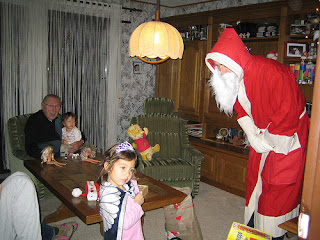
Arent kids here in Germany lucky? Well, Santa Claus comes earlier to them, that's why.
My first December season in Europe brought me a lot of surprises and one of them was that Santa Claus normally arrives here during the 6th of December.
And they dont call that man in red Santa Claus, he is known as St. Nicholas and usually wears a blue robe!
Here is one website dedicated to Nicholas that states:
The true story of Santa Claus begins with Nicholas, who was born during the third century in the village of Patara. At the time the area was Greek and is now on the southern coast of Turkey. His wealthy parents, who raised him to be a devout Christian, died in an epidemic while Nicholas was still young. Obeying Jesus' words to "sell what you own and give the money to the poor," Nicholas used his whole inheritance to assist the needy, the sick, and the suffering. He dedicated his life to serving God and was made Bishop of Myra while still a young man. Bishop Nicholas became known throughout the land for his generosity to the those in need, his love for children, and his concern for sailors and ships.
Under the Roman Emperor Diocletian, who ruthlessly persecuted Christians, Bishop Nicholas suffered for his faith, was exiled and imprisoned. The prisons were so full of bishops, priests, and deacons, there was no room for the real criminals—murderers, thieves and robbers. After his release, Nicholas attended the Council of Nicaea in AD 325. He died December 6, AD 343 in Myra and was buried in his cathedral church, where a unique relic, called manna, formed in his grave. This liquid substance, said to have healing powers, fostered the growth of devotion to Nicholas. The anniversary of his death became a day of celebration, St. Nicholas Day.
Widely celebrated in Europe, St. Nicholas' feast day, December 6th, kept alive the stories of his goodness and generosity. In Germany and Poland, boys dressed as bishops begged alms for the poor—and sometimes for themselves! In the Netherlands and Belgium, St. Nicholas arrived on a steamship from Spain to ride
a white horse on his gift-giving rounds. December 6th is still the main day for
gift giving and merrymaking in much of Europe. For example, in the Netherlands
St. Nicholas is celebrated on the 5th, the eve of the day, by sharing candies (thrown in the door), chocolate initial letters, small gifts, and riddles. Dutch children leave carrots and hay in their shoes for the saint's horse, hoping St. Nicholas will exchange them for small gifts. Simple gift-giving in early Advent helps preserve a Christmas Day focus on the Christ Child.
St. Nicholas Day is also the reason why I needed to finish my Christmas shopping earlier, because the gift giving starts earlier, too. As already a tradition here, the St. Nicholas comes to the children in kindergarten where their socks are filled with treasures. The kids sing for him, too
At home, it is usually a family day. The close relatives would join together to celebrate St. Nicholas Day. Santa Claus would arrive to give gifts to the kids, of course, the adults would get something, too. I said, Santa Claus, because he would be wearing the red robe and not the blue one, unless I sew one! And not to forget the big sack filled with gifts...
The kids are already so excited. They have practiced for a long time the 'Jingle Bells' song for Santa Claus, of course, IC said she would only sing the theme song for Pippi Longstockings :) Let's see what Santa Claus would bring.
Oh if you want to know who comes to bring the gifts during the Christmas Eve, that would be the Baby Jesus or the Christkind.


2 comments:
Loved reading about all the different traditions associated with the holidays. Thanks.
so that's where the history of santa came from. but i noticed medyo payat yung santa dyan. i wonder how the appearance of a "chubby" santa came to be :)
Post a Comment